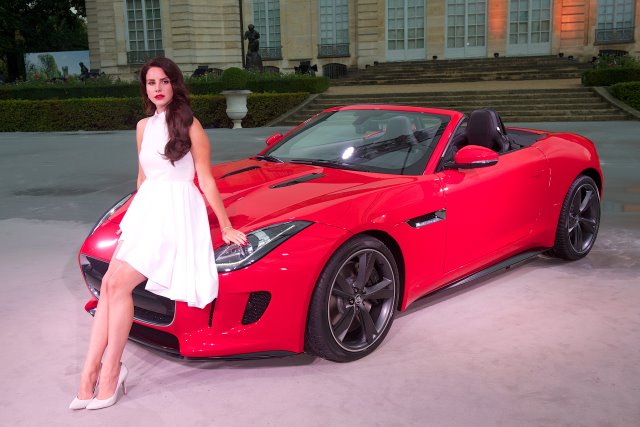
 |
July 27, 2024 Follow us |
|
|
|
|
Share this page |
 Lana del Rey and F-type She represents 2012 better than anyone else; the F-type is our pick for 2013 F sharpLucire’s 13th Car to Be Seen in is a lucky one indeed: Jaguar’s new F-type gets our nod. Jack Yan explains why
It must be Britain’s time in the limelight again: the Jaguar F-type is our Car to Be Seen in for 2013. In the car game, we’ve heard this story before: let those with passion do their job, and the products that emerge will reflect that. Bog them down in corporate nonsense, and the cars will be as dull as the Nissan Tiida. For years, Jaguar appealed to the older consumer, those who remembered its last set of glory days in the 1960s. The company released remake after remake of the 1968 XJ6, and even when that model went to an advanced aluminium construction, the looks largely stayed put. And when it tried to make a smaller Jaguar to take on the BMW 3-series, then-owner Ford decided that scaling down the XJ would do the trick. Who bought it? Older XJ buyers wanting a smaller car. While one can argue that Jaguar is merely carrying out a product plan that was developed during the Ford years, it’s hard to dismiss internal reports that Tata boss Ratan Tata is a car guy who has let his multi-milliard-dollar investment do what it does best. It’s also encouraging, from Lucire’s point of view, that Tata has been practising corporate social responsibility since the 1920s. Phil Popham, global operations’ director at Jaguar Land Rover, recently told Automotive News Europe: ‘Ford’s policies and procedures’ manual would be about three inches thick and it’s now about four sides of A4 paper. We were part of a huge automotive company in Ford but we were a very small part of that. Tata’s approach is to work with us but to allow us to run our own business with a high level of autonomy.’ While it’s clear Popham had his tongue slightly in his cheek, the newly revitalized Jaguar Land Rover earned US$2,500 million in pre-tax profit in its last fiscal year ending March 31, 2012. It generates US$2,000 million in cash annually and funds itself. And one of the products realized under Tata ownership has been the F-type sports car.
The F-type name has been bandied about since the 1970s. Jaguar was set to replace its E-type, which had grown larger and heavier over the years, from a nimble sports car to more of a grand tourer. It seemed logical for its successor to continue the trend, and what became the XJ-S was launched in 1975—in the middle of an oil crisis with a V12 engine. Not only was it bad timing, fans felt the XJ-S wasn’t sporty enough, and the car was initially maligned before earning a healthy group of fans in the 1980s. Jaguar was perhaps lucky not to give the F-type name to the XJ-S, and in the 1980s, there was talk of a “real” F-type. Projects XJ41 and XJ42 were cars in the E-type mould—at least the E-type Series III—but it suffered from a loss of direction, wavering between sports car and grand tourer, and was reportedly heavy. When Ford bought the firm, the duo was canned. Then there was talk of a smaller sports car, something that would slot under the XK series, which would compete with the Porsche Boxster. But it was only under Tata that things went full steam ahead with a smaller sports car—one which deservedly could carry the F-type name. Conceptually, the F-type, launched in September 2012, was back to basics for Jaguar. Even the company acknowledged that the F-type was its first proper sports car since the E-type. Size-wise, the F-type sits between the Boxster and Porsche 911, with engines developing between 340 and 495 PS. Its architecture is aluminium, and dynamically, it has been designed to be the best in the class. It has a 50–50 weight distribution, helping with its handling and road manners. But it’s style that this magazine looks at, and there, the F-type has got it made. As 2013 dawned, it’s the car that gets snapped when others see it on the road—surely the qualification for the Car to Be Seen in. They are still rare, there are few dissenters to Ian Callum’s team’s styling, which just seems æsthetically correct at every angle. Sure it has switchgear inside that reminds you of a Land Rover—but it’s a small price to pay when everything else about the F-type is so rewarding. As if we really needed extra promotion for the F-type, Jaguar hired one of the faces of 2012, Lana Del Rey, to push the car, with a film produced by Ridley Scott’s people. Del Rey sings ‘Burning Desire’ while the film, called Desire, markets the F-type with actors Damian Lewis, Jordi Molla and Shannyn Sossamon. It doesn’t scream footballer or WAG (just yet): the athleticism of the car says it means business and that it’s purposeful. Those who are lucky enough to own one still have something fairly exclusive. Let the nouveaux riches have their XKR-Ss instead—there’s something to be said for a clean, uncluttered design where proportions and silhouette say more about the car’s performance credentials than spoilers and big wheels. It’s a Jaguar with undeniable style, and it’s so very 2010s. In fact, it’s so very 2013—and our Car to Be Seen in. •
Below Launch shots of the F-type
The global fashion magazine
|
|
|||||||
|
Jack Yan is publisher of Lucire.
|
|||||||||
Copyright ©1997–2022 by JY&A Media, part of Jack Yan & Associates. All rights reserved. JY&A terms and conditions and privacy policy apply to viewing this site. All prices in US dollars except where indicated. Contact us here.